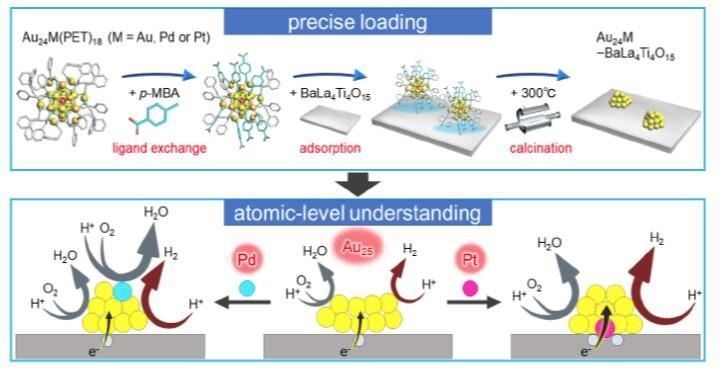Atomic-Level Understanding of Effect of Heteroatom Doping of the Cocatalyst on Water-Splitting Activity in AuPd or AuPt Alloy Cluster-Loaded BaLa4Ti4O15
Wataru Kurashige, Rui Hayashi, Kosuke Wakamatsu, Yuki Kataoka, Sakiat Hossain, Akihide Iwase, Akihiko Kudo, Seiji Yamazoe, Yuichi Negishi
ACS Appl. Energy Mater., 2, 4175-4187 (2019)
Various studies on functionalization of water-splitting photocatalysts have been performed toward their practical usage. Control of the cocatalyst has been investigated and recently, in addition to particle size control, alloying has been extensively used to achieve this goal. It is essential to investigate photocatalysts with precisely controlled cocatalysts to obtain a detailed understanding of the effect of heteroatom doping of the cocatalyst on the photocatalytic activity and thereby establish clear design guidelines for functionalization. However, previous studies have investigated photocatalysts with a variety of particle sizes and doping ratios (chemical compositions). In this study, we succeeded in loading precisely controlled Au24Pd and Au24Pt clusters on BaLa4Ti4O15, which is one of the most advanced photocatalysts, using precisely synthesized alloy clusters as the precursor. Experiments of the photocatalysts loaded with the precisely controlled cocatalysts revealed the following three features of heteroatom doping of cocatalysts: (1) Pd is located at the surface of the metal-cluster cocatalyst, whereas Pt is located at the interface between the metal-cluster cocatalyst and the photocatalyst; (2) Pd doping decreases the water-splitting activity, whereas Pt doping improves the water-splitting activity; and (3) this opposite doping effect is strongly related to the doping position of the heteroatom. Furthermore, when Pt doping is combined with surface protection of the cocatalyst with a Cr2O3 shell, a photocatalyst with higher activity and stability can be obtained. These results will lead to clear design guidelines for creating water-splitting photocatalysts with high activity and stability.
